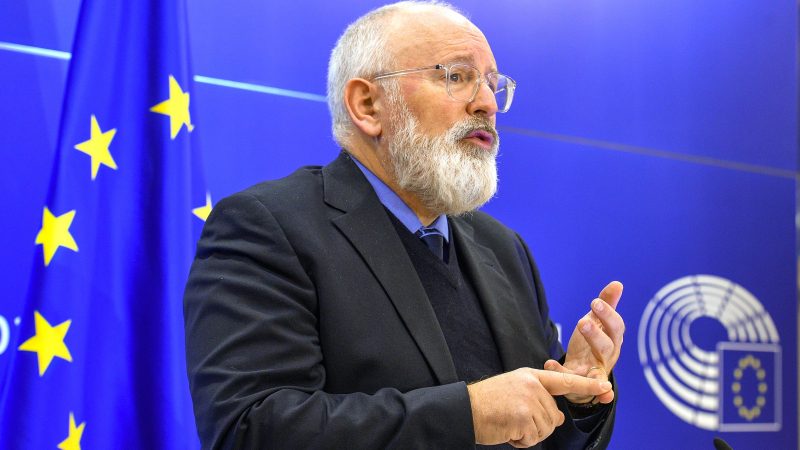By Bertrand Piccard and Frans Timmermans
The coronavirus crisis has caused a lot of suffering and uncertainty, but its aftermath offers us an opportunity to break with old habits and build a circular, sustainable and highly competitive economy, write Frans Timmermans and Bertrand Piccard.
Frans Timmermans is the executive vice-president of the European Commission. Bertrand Piccard is the founder and chairman of the Solar Impulse Foundation. EURACTIV is exclusively publishing the English version of this Op-Ed.
The coronavirus crisis is not over yet and a lot of people are suffering: those who have contracted it and their families, the healthcare workers on the frontline of the battle, workers losing their jobs, the self-employed and small businesses facing an uncertain future, and stock markets plunging.

For many, this is a terrible time.
Right now, our focus should be on fighting the virus while ensuring that we keep our economy and financial system afloat. However, as we emerge from the immediate crisis, we will need to reboot our economy as quickly as possible, getting production lines up and running, with people back to work and earning incomes again.
That leaves us with a choice: desperately fight to get back to what we had previously or try to reach a much better situation.
What did we have before COVID-19?
A sluggish, linear and carbon-spewing economy struggling to increase employment rates and quality of life, while depleting natural resources, producing dangerous waste and toxic pollutants, putting the population and industry at risk, before even mentioning climate change.
Is this really what we want to recover?
There exists another way: aiming for qualitative growth, with a circular, sustainable and highly competitive economy. How do we get there? By replacing old and polluting infrastructure with a modern, clean and efficient one, across all sectors – water, energy, construction, mobility, agriculture and industrial processes to name but a few.
This would create many more jobs and grow our GDP much more than the old way.
This is why it is a false contradiction to say that the Green Deal is a luxury we cannot afford. The floods, droughts, wildfires, sea rise, and desertification are going to hit us hard. Moreover, retreating nature and melting permafrost will confront us with more unknown viruses.
The sudden halt of mass production and transport, while hurting our economy, does give us a small taste of how it could be if we would electrify our mobility and cut down on fossil fuels in our industry. For instead of imagining clean air in the heart of our cities, one can now actually smell it.
The Green Deal is a growth strategy which happens to also protect the environment. Renewable energies and clean technologies are a massive economic and industrial opportunity that has a brighter future than going back to a fossil-fuel based economy riven with uncertainty and unpredictability.
Why is that? Because clean technologies pay for themselves, thanks to the energy and resource savings they offer. Investing in this new infrastructure is not a cost, it is an investment, a way to increase profit for industry and reduce spending for individuals.
We can build a robust renewable energy network based on solar, geothermal, biomass, ocean energy and wind power, though the possibilities go much further.
We could electrify harbours with shore-to-ship power to reduce maritime transport’s emissions, build electric vehicle charging points and hydrogen stations, set more efficiency standards for all kinds of appliances, reduce building energy consumption through efficient heating, ventilation and air-conditioning, innovative insulation technologies, or intelligent facade shading management solutions.
We could help our farmers to modernise so they can use less pesticides and take care of our environment while producing healthier products.
These technologies already exist. They represent only a few examples of the solutions identified and selected by the Solar Impulse Foundation, and its #1000Solutions challenge is here to prove it.
What these technologies need is easier access to investment, public procurement aligned with the Paris Agreement, and favourable environmental regulations that create a need for these solutions on the market.
Delaying stronger car emission standards won’t help the car industry when cities are banning combustible engines and customers are moving towards electric cars. Nor will keeping coal-fired power stations running help the energy industry while renewable energy prices continue to fall.
Doing more of the same as a rescue package cannot be the answer.
Instead of using the stimulus packages to support ‘business as usual’ – locking in obsolete economic models, and investing in assets that will soon be stranded – we should invest in the new economy to come out of the crisis in better shape than we went into it, fit for the future: sustainable, inclusive, competitive and prepared.
It will help us to create the biggest industrial market of the century, as it has become today more profitable to protect the environment than to destroy it.
This could be our best shot at doing so.






